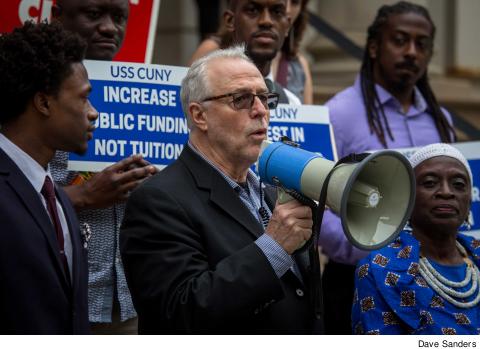 |
In late December of 2017, a task force assembled in response to a bill sponsored by City Council Higher Education Committee Chair Inez Barron completed a 21-point plan that would increase accessibility, affordability and graduation rates at CUNY. It was formed as the result of rallies, council hearings and a task force that included students and the PSC president. The proposal was ready for a public release, calling for a return to the days of free tuition, as well as to hire more full-time faculty and to increase pay for adjunct faculty. The task force, in fact, had been established by the stroke of Mayor Bill de Blasio’s executive pen in 2016.
But Mayor de Blasio’s office told the task force to wait. It wasn’t the Christmas present Barron had expected.
MAYORAL INACTION
The explanation, as Barron tells it, was that the mayor was eager to read and respond to the report, and eventually release it during the finalization of the next city budget. Despite the disappointment, this explanation seemed reasonable.
Spring forward to late May, as the city budget cycle was wrapping up, and the task force learned that the mayor’s office was delaying its response to and release of the report.
“We’re very displeased and I think it was very disingenuous of the mayor to do that,” Barron said, during a May 30 rally on the steps of City Hall just before a higher education committee hearing on the subject.
Hercules Reid, the co-chair of the task force and a graduate of City Tech, said of the mayor’s office’s sudden retreat from the report, “Is that a shame? That’s a crying shame,” and said that City Hall was “disregarding what the [task force] took time to create.”
A DETAILED PLAN
Stephen Brier, a professor of history at the Graduate Center and a member of the task force, argued that the 21-point plan outlined ways the city could support free tuition at CUNY and realize the necessary investment to add an estimated 3,000 full-time faculty positions, which had been lost since the 1975 financial crisis. It also detailed how to lift adjunct faculty pay to $7,000 per course per semester.
Other recommendations included creating an emergency fund for low-income students who encounter financial hardships while in school, working with the Department of Education to hire full-time guidance counselors to assist students in the transition from high school to college and investment in free MetroCards for CUNY students.
Noting that CUNY had been tuition-free from 1847 until 1977, Brier said, “It’s not ridiculous to think we could go back to that.”
Of course, Brier noted, achieving a final recommendation with City Hall would take negotiation, possibly enacting new taxes – like a millionaire’s tax on the state level or, as the PSC and other groups have demanded, implementing a 0.5 percent stock buyback tax that could achieve $2 billion in revenue for the state. However, he said, both City Hall and the governor’s office seemed to lack the political will to discuss those options (CUNY’s senior colleges are funded by the state, not the city).
“The city got a little complacent after the financial responsibility for four-year colleges went to the state,” Brier said.
Raul Contreras, a spokesperson for Mayor de Blasio, said in a statement, “The mayor believes that CUNY should be affordable and we continue to invest to help make that happen despite not having control over the system. In fact, the city will contribute nearly $255 million annually by 2021. We will continue to work with the City Council and state to provide high-quality, affordable education at CUNY.”
TUITION COSTS
Gotham Gazette analyzed the tuition burden at CUNY thusly: “As it stands, tuition at CUNY, where half a million students pursue either undergraduate or graduate degrees, is $6,530 per year at senior colleges and $4,800 per year at community colleges (for in-state students; out-of-state students pay much more). In the 2008-09 school year, tuition at senior colleges was $4,000 and at community colleges was $2,800. There has been a 63 percent and 71 percent jump, respectively, in 10 years.”
MORE INVESTMENT
In addition to insisting on the imposition of free tuition and investing more money into faculty, the task force put forth several recommendations for repairs and upkeep at campus buildings. The task force also call on CUNY to expand Accelerated Study in Associate Programs (ASAP), open up the state Excelsior Scholarship to part-time students in addition to full-time students and to open childcare centers for faculty, staff and students at all campuses.
Brier added that the real financial problem for CUNY was in Albany. Governor Andrew Cuomo has not only balked at addressing the historic underfunding of CUNY, but has implemented the Excelsior Scholarship, which Brier alleged still mostly benefits SUNY students in far greater numbers than CUNY students.
“He cares a lot about upstate constituents; he doesn’t care about New York City,” Brier said of Governor Cuomo, adding this is because “he’s running for president.”
Brier said the report was meant to be aspirational, to start a conversation on how free tuition and more investment for faculty could be achieved. Barron agreed that she didn’t believe the mayor would adopt all 21 suggestions in a final budget proposal.
She said, “Maybe we can get 20.”

